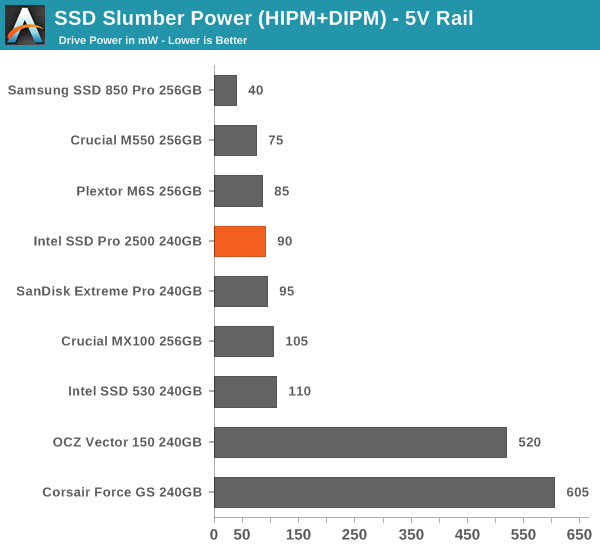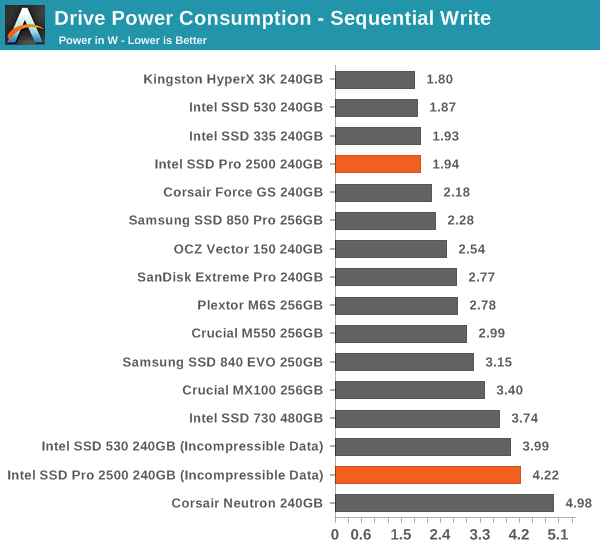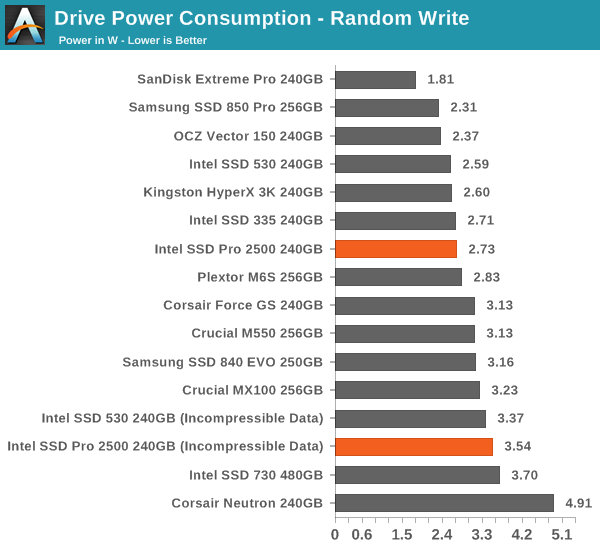Intel SSD Pro 2500 (240GB) Review
by Kristian Vättö on July 30, 2014 5:00 AM ESTPower Consumption
Compared to the SSD 530 Intel has been able to reduce idle power consumption by nearly 20%, although the Pro 2500 is still far away from Samsung's level of efficiency. Load power consumption, on the other hand, is typical SandForce with incompressible writes resulting in high power consumption.













42 Comments
View All Comments
Samus - Wednesday, July 30, 2014 - link
Ian, you couldn't be more wrong. Although Sandisk makes solid products and is a large OEM partner, they can't come close to competing with crucial\micron manufacturing capacity which inevitably makes Sandisk more expensive. When you consider crucial\micron drives have more features and better reliability than everyone else, the writing is on the wall. Sandisk (and Samsung, Toshiba\OCZ, and perhaps Intel) will continue to be relevant form their product segments but crucial\micron will always be king of ssd volume and reliability.Everyone else will be irrelevant. Kingston, ADATA, PNY, OWC, and so on, will all fail in the consumer space because they are doing what Intel is doing with this very drive, relying on outsourced components. The problem for them is they can't charge what Intel can. They'll be lucky to even break even in the future.
hojnikb - Thursday, July 31, 2014 - link
I don't know where you're from, but here in EU MX100 is almost 110€ cheaper than X210 (YES, 110€ cheaper) for 512GB capacity. So you would have to be insane to fork that much more for only a marginally better performing drive.Burner.Tom - Monday, August 4, 2014 - link
In Slovakia is the price of Crucial MX100 512GB cca 183€ with tax compared to 235€ of SanDisk X210 512GB. For me is the X210 right choice because of better warranty (3y vs 5y) and much better performance.GammaLaser - Wednesday, July 30, 2014 - link
"a study performed by the Ponemon Institute"At first I read that as Pokemon Institute :P
texasti89 - Wednesday, July 30, 2014 - link
Why on earth would someone (client or business) choose this sub-bar product over Samsung new V-NAND drives given they are priced on the same range? This product doesn't even have an Intel chip inside!galfert - Wednesday, July 30, 2014 - link
When I upgrade my client's computers they say, "Samsung? What happened with Intel?" And I tell them, "Oh those Intel SSD days are long over." I like Intel as a company, and they had the resources to keep up with the SSD innovation train. It isn't too late for them. The focus should move to M.2 PCIe with NVMe.Kristian Vättö - Wednesday, July 30, 2014 - link
I wouldn't say Intel isn't innovative in the SSD space as the P3700 was one of the first NVMe drives to ship. It's just that Intel's focus is in the enterprise market and their efforts in that front don't translate to the client market.mmrezaie - Wednesday, July 30, 2014 - link
You are talking about intel. They should be way more innovative with what resources they have, but I assume this is typical intel. They were never satisfying but just dominating.FunBunny2 - Wednesday, July 30, 2014 - link
Intel doesn't have the experience that Texas Memory has, and is the reason IBM bought them rather than Intel. Intel has cpu design and fab expertise. Enterprise SSD? Not so much. It's not a mass production venue. Whether SSD gets to the point of HDD, where the only real difference is QA of parts, is the question. It's still more about design and execution of a very different part.gsvelto - Wednesday, July 30, 2014 - link
I'm really not sure what these drives are good for. Intel already has a line of drives which offer functionality above that of consumer offerings: that's the Pro 1500 series which is in spirit (and price) an excellent successor to the venerable 320 line. That line was relatively popular even among consumer builds and in workstations precisely because it offered extra features not commonly available in consumer drives (such as encryption and power-loss protection). These drives on the other hand have basically no advantages over competitive offerings and a lot of downsides including the high price.